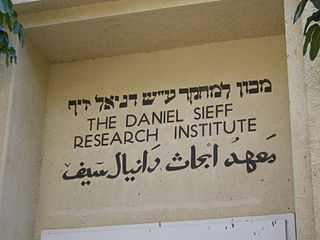
Grigory Isaakovich Barenblatt was a Russian mathematician.

The Weizmann Institute of Science is a public research university in Rehovot, Israel, established in 1934, 14 years before the State of Israel. It differs from other Israeli universities in that it offers only graduate and postgraduate degrees in the natural and exact sciences.
The year 1945 in science and technology involved some significant events, listed below.

Tata Institute of Fundamental Research (TIFR) is a public research institution located in Mumbai, India that is dedicated to basic research in mathematics and the sciences. It is a Deemed University and works under the umbrella of the Department of Atomic Energy of the Government of India. It is located at Navy Nagar, Colaba, Mumbai, with an affiliated campus in Serilingampally near Hyderabad. TIFR conducts research primarily in the natural sciences, mathematics, the biological sciences and theoretical computer science and is considered to be one among India's outstanding research centres. TIFR has a graduate programme leading to a PhD in all the major fields of study.

The Rutherford Medal is the most prestigious award offered by the Royal Society of New Zealand, consisting of a medal and prize of $100,000. It is awarded at the request of the New Zealand Government to recognize exceptional contributions to the advancement and promotion of public awareness, knowledge and understanding in addition to eminent research or technological practice by a person or group in any field of science, mathematics, social science, or technology. It is funded by the New Zealand government and awarded annually.
The MacArthur Fellows Program, MacArthur Fellowship, commonly but unofficially known as a "Genius Grant", is a prize awarded annually by the John D. and Catherine T. MacArthur Foundation typically to between 20 and 30 individuals, working in any field, who have shown "extraordinary originality and dedication in their creative pursuits and a marked capacity for self-direction" and are citizens or residents of the United States.

Michael Levitt, is an American-British-Israeli biophysicist and a professor of structural biology at Stanford University, a position he has held since 1987. Levitt received the 2013 Nobel Prize in Chemistry, together with Martin Karplus and Arieh Warshel, for "the development of multiscale models for complex chemical systems".
The Asahi Prize, established in 1929, is an award presented by the Japanese newspaper Asahi Shimbun and Asahi Shimbun Foundation to honor individuals and groups that have made outstanding accomplishments in the fields of arts and academics and have greatly contributed to the development and progress of Japanese culture and society at large.

The Otto Hahn Medal is awarded by the Max Planck Society to young scientists and researchers in both the natural and social sciences. The prestigious award takes its name from the German chemist and Nobel Prize laureate Otto Hahn, who served as the first president of the Max Planck Society from 1948 to 1960.
The ISCB Accomplishment by a Senior Scientist Award is an annual prize awarded by the International Society for Computational Biology for contributions to the field of computational biology.

Alexander George Bateman is a computational biologist and Head of Protein Sequence Resources at the European Bioinformatics Institute (EBI), part of the European Molecular Biology Laboratory (EMBL) in Cambridge, UK. He has led the development of the Pfam biological database and introduced the Rfam database of RNA families. He has also been involved in the use of Wikipedia for community-based annotation of biological databases.
Jill P. Mesirov is an American mathematician, computer scientist, and computational biologist who was the associate director and chief informatics officer at the Eli and Edythe L. Broad Institute of MIT and Harvard. She also holds an adjunct faculty position at Boston University.

Anna Tramontano was an Italian computational biologist and chair professor of biochemistry at the Sapienza University of Rome. From 2011 to 14 she was a member of the Scientific Council of the European Research Council (ERC). She was an associate editor for the journal Bioinformatics from 2005 until 2016 editing papers in the area of structural bioinformatics.












